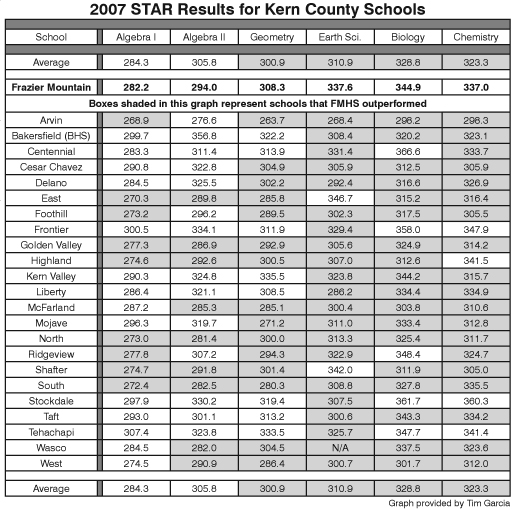‘Higher Than Kern County Averages’
By Tim Garcia and Tamara Trost, FMHS Math and Science Teachers
View Chart (pdf)
After reading the article in the July 18 issue of The Mountain Enterprise entitled ‘Parent Says High School Math, Science Scores Need to Improve,’ several teachers received calls of concern from both parents and students.
Unfortunately, in our opinion, this article does not paint an accurate picture of what STAR testing is and does not cover Frazier Mountain High School’s success.
As you will read below, our scores are better than the county or state scores in science, and are better or at par for the county in mathematics. Additionally, we have improved dramatically in both math and science when you compare 2007 to 2006.

What is STAR Testing?
STAR stands for “Standardized Testing and Reporting.” Students in grades 9-11 must take the STAR test in the subject areas of Math, Science, English and History/Social Sciences.
The scores are broken down into five categories: Advanced, Proficient, Basic, Below Basic, and Far Below Basic.
Every school in California must take this test as part of must take this test as part of the “No Child Left Behind” legislation. The goal of this legislation is that every student score at or above the Proficient level.
What’s the Target: Proficient, or Basic?
When analyzing the results of this test, however, it is generally understood that students with a Basic understanding or better have successfully met the standards as outlined by the State of California for that subject area.
Therefore, the percentage of scores at Basic or better should also be analyzed.
While it is always the goal for every student to score Proficient or Advanced in every subject area, the wide range of capabilities, reading levels, motivation, parental involvement and other factors play a role in how well a student will perform on STAR testing and how well a student will succeed in school.
How Much Are We Improving?
Furthermore, it is also common to look at how much a school is improving year to year, not with test scores, but rather with the percentage of students scoring at each of the different levels. The STAR testing website recommends comparing results from one year to the next and looking at state and county averages when evaluating results of an individual school.
Life Science Scores Above Average
The article did not have Life Science scores reported. Sophomores take two STAR tests for biology: Life Science and Biology/Life Science.
Frazier Mountain High School science scores are better than the average scores for both Kern County and the state. Hart High School District in the Santa Clarita Valley, a very well-funded Continued on page 20 High School Math and Science Scores Improving, Teachers Say ‘Higher Than Kern County Averages’ 2007 STAR Results for Kern County Schools and high socio-economic level school district, is a very high standard with which to compare scores.
We scored higher than Hart in the areas of Earth Science and Life Sciences, and were very close for both Biology and Chemistry.
Also important to note is that Valencia covers Earth Science, as many schools do, as a year-long course, whereas FMHS incorporates it into a more broad Physical Science class.
At FMHS, 82 percent of our students scored Basic or above for Biology and Life Sciences, 83 percent scored Basic or above for Chemistry, and 78 percent scored Basic or above for Earth Science in 2007.
Also impressive is that our scores improved from the 2006 to the 2007 school year. Comparing 2007 to 2006
In comparing 2007 to 2006 scores: 40 percent vs. 18 percent scored Proficient or above for Earth Science, 46 percent vs. 31 percent for Biology, and 37 percent vs. 14 percent for Chemistry. It is also important to note that Chemistry is not a required course, and 36 students took the test in 2007 versus 28 students in 2006. Not only is the number of students taking chemistry increasing, but the scores are increasing as well.
Math Results Improved Too
In the article, the area of math titled “High School Math” is actually labeled CST Summative High School Math on the STAR test website. FMHS’s scores are comparable or better than those of Kern County averages, and are edging closer to state averages in 2007.
Again, there was a considerable improvement from 2006 to the 2007 school year. Comparing 2007 to 2006 for students scoring Basic or above: 33 percent vs. 25 percent for General Math, 39 percent vs. 28 percent for Algebra I, Geometry held steady both years at 54 percent, Algebra II 50 percent vs. 26 percent, and CST Summative High School Math 60 percent vs. 32 percent.
FMHS Is Competitive
The main point of the previous article was that FMHS needs to improve its math and science scores. The way the information was presented made it appear that there is no improvement from year to year, and even worse, that the scores of our students are somehow significantly lower compared to other high schools. Our students are actually improving each year in their math and science scores.
Exit Exam Success
It is also interesting to note that the FMHS California High School Exit Exam (CAHSEE) results for sophomores taking the test for the first time show a higher passing rate than the county and the state in English, and are higher than the county and equal to the state in math: FMHS 76 percent for Math and 83 percent for English, Kern County 69 percent for math and 70 percent English, and the state 76 percent for math and 77 percent for English.
Proud Staff of FMHS
The staff of FMHS is proud to be part of this success, and we have the utmost respect and appreciation for teachers in our community.
Every educator works hard to improve teaching practices from year to year. The teachers at FMHS are a very dedicated group and will continue to do everything possible to maintain and improve student performance on these state mandated tests.
With the support of students, parents, colleagues, and the community, we believe that this is an achievable goal.
This is part of the July 25, 2008 online edition of The Mountain Enterprise.
Have an opinion on this matter? We'd like to hear from you.


